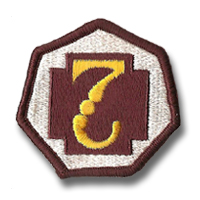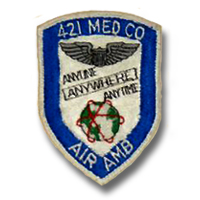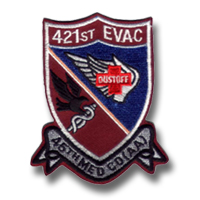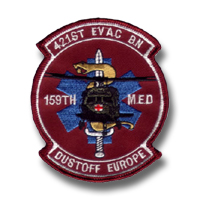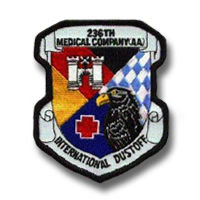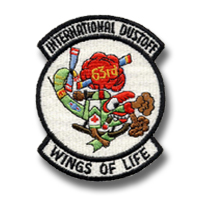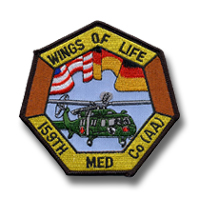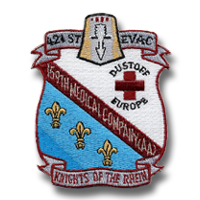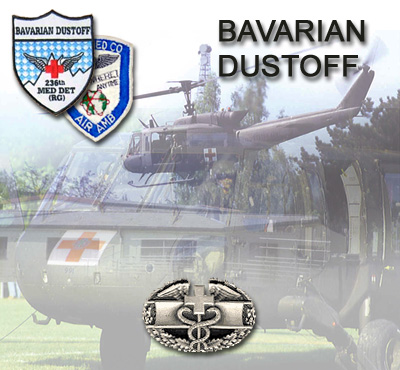| If you do
NOT see the Table of Contents frame to the left of this page, then
Click here to open 'USArmyGermany' frameset |
||||||||||||||||||||||||||||||
|
421st
Medical Company (Air Ambulance) |
||||||||||||||||||||||||||||||
|
|
||||||||||||||||||||||||||||||
|
||||||||||||||||||||||||||||||
|
|
||||||||||||||||||||||||||||||
| 421st Medical Company History | ||||||||||||||||||||||||||||||
|
||||||||||||||||||||||||||||||
| 1969 | ||||||||||||||||||||||||||||||
| (Source: Email from Ken Hattrick) | ||||||||||||||||||||||||||||||
| I arrived in Germany @ Rhein Main AB in October of 1969. I was then sent with a group to the 7th Medical Brigade Headquarters in Stuttgart). My MOS was 91A10, Medic. People were getting assignments everyday, but several of us weren't picked for whatever reason. We were finally asked if we wanted to volunteer to fly -- they would not force anyone to do so. I did, and was assigned to the 3rd Platoon @ Grafenwohr. I was sent to a hospital in Wuerzburg to upgrade my MOS to 91B20, which was needed to fly.
We shared a barracks with the Air Force. They actually ran the airfield. There were about 16 or so guys in the 3rd platoon. 6-8 pilots, 4-5 crew chiefs, and 4-5 medics. Most of the men were Vietnam vets, I am not. Shortly after I arrived, we swapped out UH-1B helicopters for D models. |
||||||||||||||||||||||||||||||
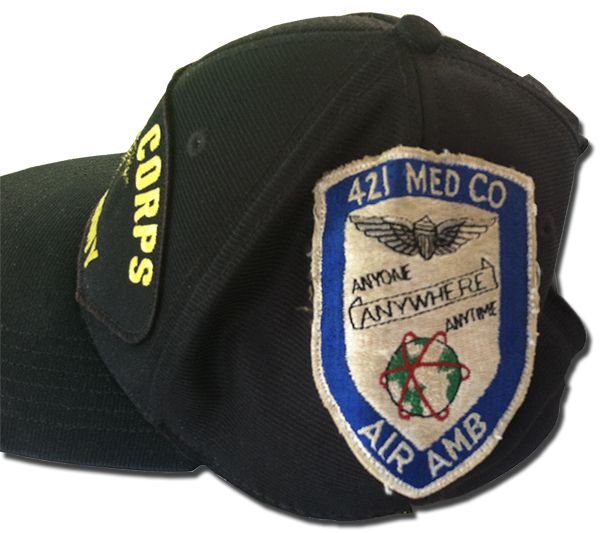 Ken still has his old unit patch that he wears on his Medical Corps hat |
||||||||||||||||||||||||||||||
|
||||||||||||||||||||||||||||||
The unit did transition to the 15th Medical Detachment in late 1970. We did not go anywhere, guys in the 15th came to Grafenwohr. I did not realize, or possibly I don't remember that the 3rd platoon designation ended up being used elsewhere @ the time, most of us did not change our blue and white "anyone, anywhere" patches to whatever the 15th used. I still have the one that was on my flight suit as well as a purple-white 7th Medical Brigade patch. I wear both of them on my Army Medical Corps cap a friend of mine purchased for me. During my time there Capt. Willie Boyd was the CO. Also there @ the time were WO-2's Mr. Kosman, Mr. Martin Lutsky, Mr. Tom Slagle, Capt. Wylie Hall and several others who were all pilots and Vietnam vets. |
||||||||||||||||||||||||||||||
| 1971 | ||||||||||||||||||||||||||||||
| (Source: STARS & STRIPES, May 28, 1971) | ||||||||||||||||||||||||||||||
| The 421st Medical Co (Air Ambulance) is headquartered at Nellingen Kaserne. The 7th Med Bde unit handles air medical evacuation for all of Germany from five locations. The units is currently in the process of receiving 36 refurbished UH-1H helicopters - Vietnam war veterans. The 421st consists of several organic platoons and attached detachments: 1st and 3rd Platoons are based at Nellingen and serve the Stuttgart area east to Munich, including the Armed Forces Recreation areas. 2nd Platoon at Schweinfurt AAF serves training areas around Schweinfurt. 4th Platoon at the Darmstadt Airstrip (Griesheim) provides air ambulance service to the heavily populated greater Frankfurt area and northern Germany, east of the Rhine and south to Karlsruhe. The 63rd Med Det at Landstuhl makes rescue missions in an area west of the Rhine between the French and Belgian borders. The 15th Med Det is responsible for the sprawling Seventh Army Training Center at Grafenwoehr. |
||||||||||||||||||||||||||||||
| 1978 | ||||||||||||||||||||||||||||||
| (Source: Email from Kim Sherburne) | ||||||||||||||||||||||||||||||
| 421st Medical Co (Air Ambulance), 1978-1981 SSG Kim Sherburne, I was assigned as a UH-1H helicopter crewchief with the 421st Medical Co at Nelligen Kaserne in April 1978 and held that position until June 1981, when I was discharged. While I was at Nelligen, all of the UH-1H's were converted to UH-1V's (the medical evacuation version of the UH-1). This included installation of the exhaust muff heating system, radar altimeter, glass windshields, improved navigation system, chemical resistant paint, etc. The 421st provided medical evacuation and support to the people of Germany on an as needed basis. So we could also be called upon to provide aircraft and personnel at vehicle accidents on the Autobahn if needed. In 1980, the 421st in Nelligen was able to complete something seldom seen in Army Aviation, when we were able to have all 12 aircraft in available flying status.This was celebrated in a flyover of Nelligen Kaserne. It was quite an event to take part in. Also, in 1980, the 421st had to respond to a helicopter accident in Schwaebish Hall, Germany, involving a CH-47 helicopter that was on a test flight. This was the fastest response I had taken part in my entire military career. We boarded the aircraft as it was pulled out of the hangar and were airborne in under 8 minutes. We took off north bound which paralleled Stuttgart civilian airports runways without getting clearance from the airport. They were a little upset but expedited our passage through their air space once the situation was explained to them. Approximately 10 minutes into the mission we were informed by Schwaebish Hall that there were 6 crewmembers on board the Chinook. I immediately got permission from my aircraft commander and made the call back to the 421st operations for an additional aircraft and crew to be launched. Unfortunately, all personnel on board the Chinook were killed, when it came apart in flight after the twin rotor system on the Chinook failed to intermix properly. In, 1981, the 421st got it's first look at the UH-1's replacement, the UH-60, Blackhawk. |
||||||||||||||||||||||||||||||
| 1987 | ||||||||||||||||||||||||||||||
| (Source: Dustoff Europe Reorganization) | ||||||||||||||||||||||||||||||
| Reorganization
of Medical Evacuation in Europe (1987) The 421st Medical Company (Air Amb), "Dustoff Europe", is reorganizing under the Army of Excellence program into an Evacuation Battalion. Currently, Dustoff Europe comprises one medical company with 25 aircraft and four medical detachments (6 aircraft each): |
||||||||||||||||||||||||||||||
|
||||||||||||||||||||||||||||||
| The 6-aircraft detachments comprise: 6 UH-60 aircraft, 4 wheeled vehicles, 30 people. | ||||||||||||||||||||||||||||||
| Under the reorganiztion, Dustoff Europe will be reorganized as an Evac Bn providing command and control for three 15-aircraft companies. The reorganization will occur in two phases: Phase One, already completed in August 1987, produced a provisional battalion hqs, two 15-aircraft companies and three 6-aircraft detachments: | ||||||||||||||||||||||||||||||
|
||||||||||||||||||||||||||||||
| Phase Two, scheduled for FY 1991, will produced a third medical company by consolidating the three remaining 6-aircraft dets at an as-yet-undetermined site. (Webmaster Note: the third medical company, designated as the 236th Med Co, was eventually formed at Landstuhl). | ||||||||||||||||||||||||||||||
| The new 15-aircraft company organization comprised 15 UH-60 aircraft, 10 wheeled vehicles, 120 people. | ||||||||||||||||||||||||||||||
| Reasons for
the reorganization: Command & Control MEDEVAC support in the COSCOM area under current medical doctrine calls for one 25-aircraft company and two 6-aircraft dets to support each division of a corps. This allocation presents a command and control problem at the detachment level. There is no single manager of MEDEVAC assets. Under the reorganization plan, the COSCOM area is supported by one 15-aircraft company for every two divisions. Additionally, one 15-aircraft company will support each division. Training Under the previous configuration, separate platoons and detachments were spread out throughout Europe which did not allow for effective unit-level training. |
||||||||||||||||||||||||||||||
|
||||||||||||||||||||||||||||||
| Additional variations of pocket patches used by Air Ambulance units in Europe (looking for details on time frames when the patches were worn): | ||||||||||||||||||||||||||||||
|
||||||||||||||||||||||||||||||
| (1) courtesy of Jim Dodson | ||||||||||||||||||||||||||||||
| If you have more
information on the history or organization of the 421st Med Co/Bn,
please contact me |
||||||||||||||||||||||||||||||
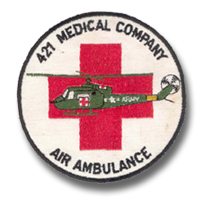 421st Med Co (AA) - 3rd Pltn 421st Med Co (AA) - 3rd Pltn |
||||||||||||||||||||||||||||||
| (Source: Email from Jim Dodson) | ||||||||||||||||||||||||||||||
I ran across your website and request for any information on the 421st Med Co.
I was stationed with the 421st Med Co, 3rd Platoon in Grafenwoehr, Germany from August 1962 through August 1964.
It was sometime in 1963 when several of us in the platoon designed a patch for our platoon (see attachment), however, at that particular time the army did not allow patches to be worn on any uniforms to include flight jackets and suits.
As you will notice, the patch I am sending you is different from the one you have on your website.
Should you have any questions, please feel free to contact me.
|
||||||||||||||||||||||||||||||
| (Source: Email from Jim Dotson) | ||||||||||||||||||||||||||||||
| My father was a medic with the 421st Med Co (AA) when they were in Illesheim, Germany. He was with the unit from 1965-68.
During the timeframe of 1967 they moved the unit to Schweinfurt where they still are today. I asked him the other day if this was the patch (see 421st Med Co pocket patch in 'Additional Variations' section) they wore, he said that was later after he left in 1968. I know in the 1978 timeframe they were wearing the shield with white background blue trim, the wings globe and anyone anywhere anytime motto. He said in 1965-68 they wore a shield patch with a crest in it, which I suspect is the one with 421st and diagonal is the 159th. I suspect the patch I sent was in the later 1969 and early 1970s. My dad recognized it but did not have an exact date on when the unit wore it. I saw an old patch from the 159th, it was made like the one I have, with the hand stiching embroidery it appears more early 1960s then later 60s. On the dustoff association link with '421 Germany' typed in these patches came up. Not mine but the old 159th; it also has a large red cross in the center. I believe it may be from 1961 when the unit was first activated but this is only guessing from the old style patch work and similar features to the old 159th patch dated 1961. I looked at patches from the late 1960s and the early 1970s and the embroidery is far more advanced. I have some early 1960s handmade and they are similar to the 421st patches. Still working on it, but keep you posted. My dad and I are very fond of this unit. I was medevaced as child of 6 years of age from illesheim to Nurnburg Army Hospital by this unit. My luck was my dad was the medic on duty that night. Maj. McBride was the unit commander and Aircraft commander that night with copilot Capt McDonald. My dad, Larry Dotson, was the medic and the crew chief was Specialist, not sure of rank, McVicker. We returned to Germany and I worked in the emergency room at Wuerzburg Army Hospital. There I was later able to assist the 421st in transports of patients. I remember Maj. McBride allowing me for a moment to watch the trains from the air coming out of Nurnburg. And they treated me really great. So as you can tell this unit is always in my heart. I am now a 100 percent disabled veteran, but their kindness and professionalisim is what made me become a Army medic. And what I saw as a child is the same care and dedication I gave my troops. I became disabled going to the aid of another soldier. If I could I am in search of a 421st patch from today, if you know of anyone who may sell me one, I would deeply appreciate it. I am not sure of the crew chiefs rank at the time because back then then they had spec 5-6 besides the 4. I will research this a little more. And will immediately notify you of my findings. Thank you for your time and assistance. Jim Dotson |
||||||||||||||||||||||||||||||
|
|
||||||||||||||||||||||||||||||
| 15th Medical Detachment (HA) | ||||||||||||||||||||||||||||||
| (Sources: Email from Alfons Kraus) | ||||||||||||||||||||||||||||||
| Constituted as
the 15th Malaria Control Unit on 1 January 1943, the unit was activated
at the Service of Supply Unit Training Center in New Orleans on 25
January 1943. It staged at Camp Stoneman, California between 29 March
1943 and 22 April 1943, and sailed for Australia on 18 May 1943 on
the USS Cape Flattery. It was reorganized and redesignated the 15th
Medical Composite Unit on 13 July 1944 and reorganized and redesignated
again on 25 April 1945 as the 15th Malaria Control Detachment. The
unit served in Australia until 7 July 1943, then in New Guinea until
30 April 1945, and in the Philippine Islands from 3 May 1945 to 2
November 1945 when it was inactivated. It was redesignated the 15th Medical Detachment on 27 March 1951, and activated at Karlsruhe, Germany on 3 May 1951 where it served until 28 October 1954. It was transferred to St. Nazaire, France where it was inactivated on 5 February 1955. The unit was activated again at Fort Ord, California on 25 March 1961 as the 15th Medical Detachment (HA). The 15th was organized from the assets of the 47th Medical Platoon (formerly the 37th Medical Detachment), which had been inactivated on 25 March 1961. The unit sailed on 9 October 1961 from Hampton Roads, Virginia on the USNS Gordon for Bremerhaven, Germany, where it arrived on 21 October 1961 as part of the support for the Berlin Crisis buildup. Upon arrival in Germany, the 15th traveled by train to Bad Kreuznach where it opened for business with four H-19D helicopters. In late 1963 or early 1964, the H-19s were replaced with five H-13G helicopters. In May 1966, the unit received three H-34C helicopters that allowed it to provide on board, in transit medical care. Another H-34C was added in 1966, but the unit had only four to five pilots at any given time, and maintenance was a common problem, with usually only two of the four aircraft flying. In December 1966, the unit relocated to Schleissheim Army Airfield at Oberschleissheim, Germany. The 15th provided coverage for the 24th Infantry Division and the Army Recreation Areas at Garmisch, Chiemsee and Berchtesgaden. It also did mountain rescue work with the German police. In March 1967 one of the lesser-known incidents of the Cold War ended peacefully at Schleissheim Airfield. The Great Dumpling War ended when the Commander of the 15th and Airfield Commander, then-MAJ Donald G. Murphy, agreed to keep his aircraft above 1500 feet when flying over the Munich suburb of Pasing. One of Pasing's residents, Helmut Winter, had been so annoyed by low flying aircraft that he constructed a crossbow and fired over 120 potato dumplings at the helicopters before the peace accord was reached. In July 1968, the unit relocated again, this time to Gablingen Army Airfield, about ten miles from Augsburg, Germany, where in December, it received three UH-1D helicopters. In December 1970, the 15th relocated again to the Seventh Army Training Center at Grafenwoehr and received a fourth UH-1D aircraft. Two UH-1H aircraft were added in April 1971, and between June and November the other four aircraft were exchanged for UH-1H Hueys. The unit was redesignated as the 15th Medical Detachment (RA). When the 15th relocated to Grafenwoehr, there were no facilities available and the unit set up in an old motor pool on the South side of the main post. A landing pad was established in a 1.5-acre parking area and the motor maintenance barn was used as an aircraft hanger. There was room only for one aircraft at a time and the clearance was so tight that the air pressure in the ground handling wheels had to be reduced to the point that the aircraft would barely roll to get the helicopters in and out of the maintenance barn. There was no protection from the winter environment for the other aircraft. In fall 1971, there was a fatal accident that killed a medic on takeoff at night in poor weather. The unit was directed to move all operations to the Grafenwoehr Army Airfield. But there was no hanger and no funds to build one for two years. So unit maintenance continued in the motor pool barn. In July 1972, the high profile, international Joint Operation Mystic Mission concluded at Hohenfels. There was a very large base camp built using German "Fest" tents, tough translucent fabric stretched over arched laminated wood beams. The 15th had provided standby support for the Operation, and the suggestion was made to COL Tibbets, the Seventh Army Training Center Commander, that the largest of the tents would make a suitable hanger for the 15th when it was no longer needed for the Operation. COL Tibbets agreed and with the help of LTC Raymond Salmon, 421st Medical Company Commander, additional funds were provided from the 7th Medical Brigade to move and reassemble the large tent. It was disassembled and moved by Skycrane to Grafenwoehr, where engineers modified the door to accommodate the UH-1Hs. The tent was provided with additional lights and running water and could accommodate three Hueys, four in a pinch. Maintenance offices and parts storage were also stored inside. The units 64-foot canvas field storage tent was erected to house the fifth aircraft, leaving only one to be subjected to the elements. A large spaceheater provided heat. In bad weather the standby aircraft was situated just inside the door with ground handling wheels on and the tug attached. Response time was dramatically improved in winter with no snow or ice to remove and warm fluids and batteries in the aircraft. The motor maintenance barn was used only for vehicle maintenance. The result was the only "Glow in the Dark, Bier Fest Tent" hanger in the Army inventory. For years it served as a conversation piece. One can only imagine what the Warsaw Pact troops in Czechoslovakia thought. Grafenwoehr was so close to the Czech border that troops there could not help but notice it if they were at any altitude. In January 1987, the Hueys were exchanged for UH-60A Black Hawks, and the unit was redesignated as the 15th Medical Detachment (RG). The 15th was inactivated at Grafenwoehr on 15 October 1989. Its aircraft and personnel were transferred to the 159th and 236th Medical Detachments as they reorganized into 15 aircraft Companies. While it was active, the 15th provided medevac support to the North Bavaria area of Seventh Army through the 7th Medical Command. By the mid-1980s, it was subordinate to the 421st Medical Company (AA), and later to the 421st Medical Battalion (Evacuation). The 15th was awarded WW II campaign credit for New Guinea and Southern Philippines. |
||||||||||||||||||||||||||||||
|
|
||||||||||||||||||||||||||||||
| 159th Medical Company (AA) | ||||||||||||||||||||||||||||||
| (Source: Port Reporter, May 16, 1986) | ||||||||||||||||||||||||||||||
159th Medical Detachment - "We move any patient, anywhere" |
||||||||||||||||||||||||||||||
| 236th Medical Company (AA) | ||||||||||||||||||||||||||||||
| (Sources: various issues of the MEDCOM Examiner and the History of the 236th Medical Detachment (RA), by MARK M. HOUGH | ||||||||||||||||||||||||||||||
| The 236th
Medical Detachment (RA), Fort Sam Houston, Texas, was moved
to Germany in 1973. The main body of the Detachment departed on 27
March 1973 from Charleston Air Force Base, South Carolina and landed
at Rhein Main Air Base, West Germany. The Det was located at Gablingen Kaserne, about 10 miles north northwest of Augsburg and was under the command of the 421st Medical Company (AA), a subordinate unit of the 7th Medical Brigade. Its mission was to evacuate patients from Bavaria, Italy and Austria. With the transition to UH-60A Blackhawk helicopters that took place in 1986/87, the unit was redesignated as the 236th Medical Detachment (RG). On 16 October 1989, the 236th was again reorganized and redesignated, this time as the 236th Medical Company (AA), by combining the assets of the 15th, 63rd and 236th Medical Detachments which were inactivated. The Company also moved to a new station -- Landstuhl, Germany. Currently (early 1990s), the company is under the command and control of the 421st Medical Battalion (Evacuation) of the 7th Medical Command. It comprises 15 UH-60A helicopters. Because of its theater of operations coverage, it is known as, "International Dustoff," the name which it inherited from the 63rd Medical Detachment. |
||||||||||||||||||||||||||||||
| (Source: Mehmet Aydin) | ||||||||||||||||||||||||||||||
|
||||||||||||||||||||||||||||||
|
|
||||||||||||||||||||||||||||||
| Newspaper articles | ||||||||||||||||||||||||||||||
| (Source: MEDCOM Examiner, April 1985) | ||||||||||||||||||||||||||||||
| "Anyone,
Anywhere, Anyplace" More than a motto to the soldiers of Dustoff Europe by Demaris Kogut |
||||||||||||||||||||||||||||||
|
||||||||||||||||||||||||||||||
|
|
||||||||||||||||||||||||||||||
| (Source: MEDCOM Examiner, July 1986) | ||||||||||||||||||||||||||||||
| 63rd Med Det
has best safety record in Europe by Jim Ward |
||||||||||||||||||||||||||||||
|
||||||||||||||||||||||||||||||
|
||||||||||||||||||||||||||||||
|
|
||||||||||||||||||||||||||||||
| (Source: MEDCOM Examiner, October 1987) | ||||||||||||||||||||||||||||||
| 421st Evac
Bn activates by Shaun Gearon |
||||||||||||||||||||||||||||||
|
||||||||||||||||||||||||||||||
|
|
||||||||||||||||||||||||||||||
| (Source: Augsburg Scene, August 18, 1989) | ||||||||||||||||||||||||||||||
| 236th Med
Det moves to new home by Jim Fulbrook One thing is for sure in the military, there are always changes underway. Well, big changes will take place with "Bavarian Dustoff", the 236th Medical Detachment, when the unit completes a major move to Landstuhl where it will incorporate with other units to become the 236th Medical Company. The 236th was first flagged during World War II, then again during the Korean War. During the Vietnam conflict the unit became an aeromedical evacuation unit for the first time, flying the UH-1 (Huey) helicopter out of Da Nang from 1968 to 1972. The 236th returned to CONUS in 1972 for a short stay, then was stationed in Germany in 1973, where it has served the Augsburg community for more than 16 years. In 1987, the unit received six UH-60 (Blackhawk) helicopters. Bavarian Dustoff has been composed of up to 50 soldiers, 12 of whom are rated aviators (8 Warrant, 4 Commissioned). The unit has been located at the Gablingen hangar, although one UH-60 is kept at Flak Kaserne on call to provide a rapid "first up" emergency response when needed. Fear not though, fellow citizens, the emergency response helicopter will remain a permanent part of the community, but the soldiers performing the mission will have their home base elsewhere. The 236th moving and becoming a Company is part of a major reorganization of Dustoff Europe where the parent unit, the 421st Medical Company became the 421st Medical Battalion (EVAC) composed of three companies formed from the numerous detachments and platoons stationed all over Germany. Once the 236th Medical Company is formed (provisional 15 Aug 1989), it will be composed of the 236th, 63rd and part of the 15th Medical Detachments in Landstuhl. Part of the enlisted barracks at Flak Kaserne will become the transient quarters where flight crews will remain on call or on beepers to receive missions. Aeromedical evacuation will still be handled the same way through the 34th General Hospital Emergency Room and the Patient Administative Division (PAD). Aircrews and helicopters will come alternately from the different Dustoff Companies and rotate every week. So, Bavarian Dustoff as we knew it has ceased on Aug. 1, when the unit packed up. For some time now the unit has been preparing. Many of the unit's soldiers will move to Landstuhl although some have received curtailments, will PCS on schedule after short stays with other units, or move elsewhere to include Heidelberg and Darmstadt. To Capt. Ben French, the departing Commander, and the rest of the unit we wish you Godspeed and best wishes, and look forward to continued good service for emergency aeromedical evacuation from Dustoff Europe. Editor's note: Jim Fulbrook is a free-lance writer, residing in Augsburg. |
||||||||||||||||||||||||||||||
|
|
||||||||||||||||||||||||||||||
| Related Links: |
||||||||||||||||||||||||||||||
